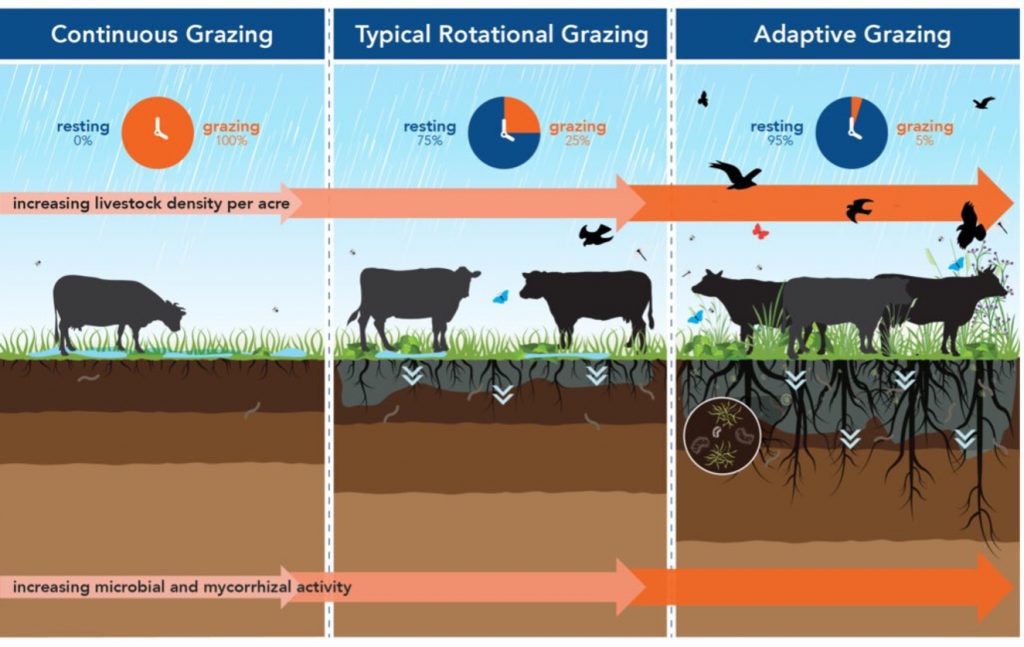Six Principles of Regenerative Agriculture, Explained
Louise Penn
Jan, 03 2023The book ‘Dirt to Soil’ by Gabe Brown introduced me to regenerative agriculture like it has for so many others. I have always had an interest in sustainability, but the concept of regeneration was an ideology that made so much sense after reading the book. Why would we want to sustain our soils and stand still? We should be regenerating our soils. I have since read many other books and attended events all over to see UK farmers putting his principles of regenerative agriculture into practice, as well as helping to implement these on my own client’s farms.
The concept of regenerative agriculture has started to gain traction in the UK. It’s not surprising that when Gabe Brown announced he would be coming to the UK to do a one-day regenerative workshop that it sold out within the first few days. Over 250 growers and advisors attended the workshop to learn how to regenerate their soils. There had to have been thousands of acres of land between all those growers and to witness everyone there so engaged and enthused throughout the day was quite something.
Gabe Brown and his colleagues Shane New and Dr Allen Williams from Understanding Ag had come all the way from America to share their knowledge. Whilst America has a very different climate to the UK our soils are all still made from sand, silt, and clay. Regardless of the different challenges, we may face here, the basics of soil science and nutrient cycles are the same.
There are six main principles of regenerative agriculture; the fundamentals of which are explained thoroughly in ‘Dirt to Soil’. The workshop went into greater detail about the mechanics behind how these regenerative practices enhance nutrient cycling, soil biology and structure. Below, I have included some of the most interesting pieces of additional information I learned in relation to the six principles on the day.
Six Principles of Regenerative Agriculture
1. Context
- This principle recognises that each farm has its own set of challenges. It could be environmental constraints such as soil type, rainfall or season length. Financial or family members being unwilling to change.
- Sceptics will call this principle the “insurance policy” of regenerative agriculture.
2. Limit Disturbance
- There are three types of disturbance that can impact how the soil functions: physical, chemical, and biological.
- Physical disturbance occurs in the form of tillage which destroys the biological and ecological integrity of the soil ecosystem. Soil microorganisms inhabit the pore spaces and cracks between soil aggregates that are held together by ‘biotic glue’ called glomalin. These microorganisms are vital in the cycling of carbon, nitrogen and phosphorus which are vital to plant growth. When we till the soil, we destroy these pore spaces and the homes of this vital soil biology we need for our cycles to function. When tillage collapses these air spaces, the water holding capacity of the soil also decreases. Gabe agreed as do many farmers who have moved to a direct drilling system that tillage should be decreased overtime.
- Chemical disturbance can be done through the application of fertilisers and pesticides. Synthetic fertilisers are detrimental to mycorrhizal fungi. The relationship between microbes and plant roots is interrupted when plants no longer need to trade carbon with soil microbes in order to access soil nutrients. Later in the season when this excess nitrogen is unavailable, there are no existing associations between the plant and soil microbes. Plants then start building these associations and producing root exudates to attract these microbes at a time of year when they should be sending carbon (energy in the form of sugars) to the seed head to produce grain. Increased education and rising fertiliser prices have encouraged farmers to identify the optimum amount of nitrogen required for their own crops.
- Biological disturbance occurs when we don’t have living roots in our soil or grow a monoculture. This is explained further in principle 4 and 5.
3. Armour the Soil Surface
- Soils should always be covered by growing plants and/or their residues. This is important for a number of reasons:
- Moisture retention by limiting the evaporation of water from the soil surface
- Soil temperatures staying at an optimal level
- Preventing soil erosion (through water and wind)
- Suppressing weed growth
- Providing a habitat for arthropods who shred residues
- To ensure soil is covered at all times growers must consider their crop rotation and what combination of cover crops species they are using relative to the amount of soil biology they have. This is where an understanding of the carbon to nitrogen ratio of different plants and their residues comes in. There will be times when you want to keep residues on the soil surface and times when you would like them to disappear.
4. Build Diversity
- In nature there are no monocultures, we need plant diversity to produce healthy soil. Gabe explained some research that had found increasing the number of plant species had increased total biomass production compared to a monoculture. He also added that diversity will also reduce weed, disease and pest pressure and improve plant nutrient cycling and soil function.
- Providing more diversity in plant species will provide diversity in the diet of the microorganisms that live in the soil.
- This could be done in many ways:
- Adding more crops to your rotation
- Companion cropping (Beans and oats/wheat, Clover understories, OSR and buckwheat)
- Herbal leys
- Cover crops – Gabe recommends a minimum of 6 to 7 species
- Throughout the day Gabe kept bringing the conversation back to profitability. Ultimately it is our ‘cash crops’ that make us money. He admits that you cannot always achieve diversity but there will always be an opportunity to do so within the cropping year. Even if it is just getting something out the shed to create a polyculture then this is better than nothing.

influence of functional diversity and composition on ecosystem processes).
5. Keep Living Roots in the Soil
- Soils are not meant to be bare, as we see out in the field when nature grows weeds in areas of bare soil. Gabe explains that he doesn’t like to leave soil without a growing crop in it for more than a month. In the UK this would occur after harvest. This could be leaving volunteers growing before planting a winter crop or sowing cover crops. The latter would be preferable even before a winter crop as the more diverse plants growing the more diversity in our soil.
- We need living roots for the soil to cycle nutrients effectively. Plant roots produce ‘exudates’ – these are carbon-rich molecules that are a food source for microbes. In return microbes and mycorrhizal fungi extract nutrients from soil particles and rock fragments and break organic matter down into soluble nutrients for the plant. These microbes need carbon to survive, if we don’t feed them through living roots in the soil they will instead feed on organic matter (their home) and soils will degrade. Having living roots in your soil for as long as possible will increase organic matter, which in turn will support more soil biology meaning there will be higher levels of available nutrients to plants.
6. Integrate Animals
- Dr Allen Williams led an afternoon workshop focusing on ‘adaptive grazing’. A form of grazing that allows us to be fully adaptable and flexible to ever-changing conditions. This was a new concept to me but builds on the grazing techniques we are familiar with. Like our soils instead of being prescriptive in what we do it involves making changes according to the current conditions, observations in the environment and specific goals and objectives. The ultimate goal is to avoid over-grazing to mimic what happens in the wild and to promote diversity.
- In an adaptive grazing system you create what Dr Allen calls ‘disruptions’ which aim to create a number of positive compounding effects. This could be through:
- Altering stock density
- Moving through rotations in different patterns
- Alter paddock configuration
- Alter grazing heights
- Alter species order or mixes
- Altering time of season/year a paddock is grazed and the number of grazing days (this emulates a natural, wild grazing process)
- Livestock trigger a microbial reaction when they graze. Plant roots send out root exudates and pump carbon into the soil to support biology- this biology in the form of microbes come and bring nutrients to the plant to heal. Livestock therefore stimulate these nutrient cycles and support soil biology. Their urine is also full of microbiology and rich in ammonia.
- Dr Allen discussed epigenetics – the environmental conditions you subject your stock to will alter their genetics for the next generation. He explained how being strict on which animals you breed and cull is important to build a herd that will thrive off your ecosystem.
- Gabe and his colleagues are selling their livestock at a premium, marketing it as grass-fed and regeneratively reared. They have found that their animals have higher levels of Omega 3 and are more nutrient dense on a regenerative system. Perhaps this is a market that could develop in the UK as consumer start to question where their food has come from and how sustainably it has been produced.
For anyone that hasn’t ventured down the rabbit hole of regenerative agriculture, I encourage you to read ‘Dirt to Soil’. The Soil Owner’s Manual by Jon Stika is also a great book that explains the basics of improving soil health. My biggest take-home from the day was when Gabe said “Regenerative Agriculture is a thinking persons game. You must think and observe”. Every decision you make on farm as a grower or agronomist has either positive or negative compounding effects. To ensure these effects are positive we must spend time thinking and observing. Since I have immersed myself in the science of regenerative agriculture, I see so much more out in the field than I ever did before.
We have worked with numerous clients to use these principles to produce five and ten year plans along with budgets and agronomic support to implement these practices and regenerate their soils. If you are interested in regenerating your soils and moving towards regenerative practices, then get in touch.





